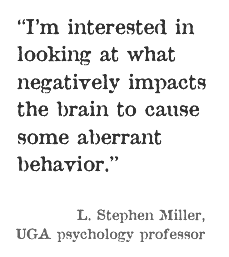


by Kathleen Cason
Intro
| Hallmarks of schizophrenia
| Social skills
Relative
risks | Seeing is believing

Hallmarks of schizophrenia
The most common misperception of schizophrenia is that it is the same as split personality. It’s not.
Instead, people with schizophrenia can’t distinguish what is real from what is not. And it strikes one in every hundred people, often during their college years.
To schizophrenics, the world is a jumble they can’t comprehend. They hear, see, even smell or feel things that are not there. Speech and thoughts may be incoherent. They may believe their thoughts are being controlled. These are the hallmark symptoms, the ones that respond to medication.
But there are other symptoms that the drugs don’t help. A person’s ability to feel emotion may be dulled or gone altogether. Combined with eccentric behavior, a person with schizophrenia may become socially isolated.


L. Stephen Miller, UGA psychology professor
“I did therapy with a patient for two years who really, honestly believed that people were able to hear his thoughts — a problem that impacted his life in a thousand ways,” Miller said. “He wore headphones, he would talk out loud all the time and use profanity to cover-up what he believed other people could hear.”
Once thought to be caused by personality defects, bad parenting or demons, scientists now know that schizophrenia has a biological basis: It has to do with faulty brain wiring. Brain abnormalities that occur during development are not evident until late adolescence or early adulthood. The result is a dramatic disturbance in the way a person thinks.
But getting at the underlying biological and genetic mechanisms is a tough problem.
For one thing, scientists believe that multiple genes are involved, with each contributing a small effect. In fact, while schizophrenia runs in families, it’s not really simply a matter of genetics. Studies of identical twins show that one twin has only a 48 percent risk of developing schizophrenia if the other twin has the disease. Both twins would be expected to have the illness if it were solely a genetic disease because they share the same genes. What is inherited seems to be a genetic vulnerability to the disease, not the disease itself.
Apparently, environmental factors — perhaps a virus, poor prenatal nutrition or complications during birth — must interact with several genes on different chromosomes for illness to occur. Scientists believe that this interaction of genes and environment somehow disrupts the cell migration and reproduction that occurs during normal brain development.
“There are lots of different reasons someone may have schizophrenia. The brain pathology seems to be inherited, probably the result of some neuro-developmental impairment,” Miller said. “But this is where we get unsure whether it’s genetic — a problem with genes — or whether it is due to some insult early on during a critical time in the brain development.”
To complicate matters, the very medications that keep the hallucinations, delusions and other symptoms at bay make it difficult to study the link between deficits in cognition and how the brain works.
Miller attempts to isolate the cause by taking parallel paths: studying individuals with related but less severe disorders and studying relatives of schizophrenics. In fact, many scientists now focus more on patients’ relatives than on the patients themselves.
Intro
| Hallmarks of schizophrenia
| Social skills
|
Relative risks | Seeing
is believing
For comments or for information please e-mail the editor: jbp@ovpr.uga.edu
To contact the webmaster please email: ovprweb@uga.edu
![]()